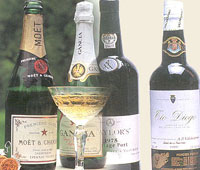

The classic Iberian fortified wines — sherry, port, malaga and madeira — and Italy's marsala, have a wide spectrum of tastes, from austerely dry to positively sweet. Wines may be sweet when young, but can mature into relative dryness, as with vintage port. This maturing is done by the winemaker in virtually all cases, vintage port being the exception. Most fortified wines are very much controlled by their makers, who decide on the style and blend accordingly.
All sherries start off dry, and gain their sweetness from the blending in of sweeter wine. Manzanilla and fino sherries are never sweetened, but amontillado and oloroso, although classically dry, are often made as a medium or sweet wine.
Montilla wines are not necessarily fortified, but they are made in much the same way as sherry and come in a similar range of styles.
Port gains its sweetness from naturally sweet grapes. Because the fermentation is stopped before the sugar is all converted to alcohol, the port tastes sweet. Age lends dryness: old tawnies, and especially old (bottle-aged) vintage port, become drier.
Countries such as Australia and South Africa, that have imitated the classic Iberian styles, sherry and port, make wines ranging from dry to very sweet; the style will be indicated on the label.
France's vins doux naturels fall into two types: the red wines of Banyuls, Maury and Rivesaltes are aged — sometimes for several years — in order to achieve their complex nutty tastes; the white wines made from Muscat grapes are best drunk fresh and young.
Italian wines that use the word liquoroso on the label are always fortified, and usually sweet.
The French products known as vins de liqueur, such as pineau des Charentes, floe de Gascogne and macvin du Jura, although they are fortified to have an alcohol content of between 16 and 22°, are not true wines (the grape juice is not fermented before fortification) and are not included in these charts
Fortified wines cover quite a wide range of strengths. Some are lightly fortified, with 14-15° of alcohol, while most ports and some sherries weigh in at 20°, which is twice as strong as many table wines.
Some fortified wines are shipped from their region of production at a higher strength than the wine sold locally. This is especially true of fino sherry, which can have quite a distinctly different character in Jerez from, say, London. This is a relic of the old purpose of fortification.
|
|
|




